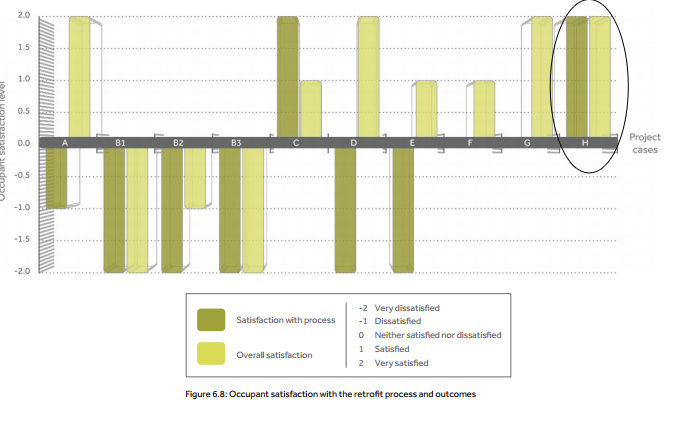Of 24 London projects completed in the Technology Strategy Board’s Retrofit for the Future programme, ten houses were chosen for detailed analysis by the UCL Energy Institute and the Institute for Sustainability. The Grove Road social housing retrofit was the only project highlighted as receiving full marks for both ‘occupant satisfaction with the process’ and ‘occupant overall satisfaction’, as reported in the recent publication “Retrofit insights: perspectives for an emerging industry” (Professor Bob Lowe, UCL Energy Institute & The Institute for Sustainability, 2012)
The report highlights the following points which are all the more remarkable considering this project was one of only three of those investigated that carried out deep retrofits while the residents remained in-situ:
- “keeping occupants informed of progress, together with a well-managed work programme, not only helped occupants to cope, but also affected their overall satisfaction with the retrofit process.”
- "No other project teams in the study exhibited such a relationship with the occupants.”
- “frequent formal meetings between the design team, client, occupants and energy consultants were structured into the work programme to allow all members to play their part in establishing performance goals.”
- “strategies and options for achieving these goals were formulated, based upon an integrated analysis of how different retrofit systems would work given the health conditions of occupants.”
- “an informal engagement and communication process between the occupants and the project team went on throughout."
- “the occupants formed very good relationships with their project team, and this appears to have influenced their evaluation of the process.”
- “the availability of a full range of physical monitoring data appears to have directly related to the level of personal engagement by the architect with the occupants.”
- “Primarily because of the effort put into the fabric … the highest internal temperatures and lowest energy use would be expected”
- “Led by the architect and supported by the housing association, team members often blurred their professional boundaries and adopted a range of different roles.”
- "the leadership role was formally taken by the architect. He had long-standing working relationships with a small mechanical and electrical consultant and a small number of contractors. By working collaboratively on a number of projects over the previous five years they had built up collective knowledge, shared practices and capacity for retrofit.”
- “the team deliberately set out to create ‘islands of innovation’ within which technology and practice could be fruitfully developed. These islands of innovation consist of small groups of individuals and companies that are relatively weakly connected to the culture, systems and practices of the rest of the UK industry, but that are very well connected with each other. Such islands of innovation are often interconnected, not just within the UK but internationally.”
- “Case H clearly succeeded in reducing energy use and fuel bills.”
- “They tended to take greater account of clients’ and occupants’ needs, in particular engaging with occupants throughout the retrofit processes to resolve design, installation, commissioning and operational problems."
- “The strategy which stands out most is Passivhaus” (section 3.1)
- "The PTs responsible for Cases D and H provide an example of systematisation of practice at several levels. The architect (an SME) who led both teams has spent the last six years refining designs and working practices and developing a network of suppliers and contractors to support Passivhaus retrofit. The fact that his practice undertakes its own physical monitoring underpins a knowledge-based business model which has allowed it to develop impressive technical and process expertise in a relatively short time."
- "The Passivhaus approach could be seen as one way of making deep retrofit routine, as the knowledge base of the Passivhaus community accumulates on a case-by-case basis. Passivhaus standard retrofit requires not only technical know-how but also skills in building supply chains and systems of support within PTs. As knowledge, the skills base and networks grow, a position may be reached in which PTs will be able to respond routinely to a wide diversity of house types and households."
